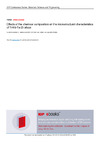Identificador persistente para citar o vincular este elemento:
https://accedacris.ulpgc.es/jspui/handle/10553/69999
| Campo DC | Valor | idioma |
|---|---|---|
| dc.contributor.author | Tudoran, S. | en_US |
| dc.contributor.author | Voiculescu, I. | en_US |
| dc.contributor.author | Geantǎ, V. | en_US |
| dc.contributor.author | Vizureanu, P. | en_US |
| dc.contributor.author | Mîrza Roşca, Iulia C. | en_US |
| dc.contributor.author | Pǎtraşcu, I. | en_US |
| dc.contributor.author | Gǎlbinaşu, B. M. | en_US |
| dc.contributor.author | Ciocoiu, R. | en_US |
| dc.date.accessioned | 2020-02-05T12:51:50Z | - |
| dc.date.available | 2020-02-05T12:51:50Z | - |
| dc.date.issued | 2019 | en_US |
| dc.identifier.issn | 1757-8981 | en_US |
| dc.identifier.other | Scopus | - |
| dc.identifier.uri | https://accedacris.ulpgc.es/handle/10553/69999 | - |
| dc.description.abstract | Among the biomedical alloys, titanium based alloys are currently the best solution for implantation as a result of their low levels of toxicity. To improve mechanical properties, a series of chemical compositions of some titanium alloys have been studied over the past 15 years, to provide elasticity values as close as possible to bone. The paper presents the main mechanical and microstructural characteristics of Ti-Nb-Ta-Zr alloys compared to other titanium brands. It was found that in the absence of heat treatments, the highest hardness values (437HV1) were obtained for the Ti15Nb7.6Ta8Zr alloy, and the lowest hardness value (259 HV1) was obtained for the Ti98.4 alloy. | en_US |
| dc.language | eng | en_US |
| dc.relation.ispartof | IOP conference series. Materials science and engineering | en_US |
| dc.source | IOP Conference Series: Materials Science and Engineering [ISSN 1757-8981], v. 572 (1) | en_US |
| dc.subject | 3312 Tecnología de materiales | en_US |
| dc.subject.other | Titanium | en_US |
| dc.subject.other | Ti-Nb-Ta-Zr | en_US |
| dc.subject.other | Materials | en_US |
| dc.title | Effects of the chemical composition on the microstructural characteristics of Ti-Nb-Ta-Zr alloys | en_US |
| dc.type | info:eu-repo/semantics/conferenceObject | en_US |
| dc.type | Conference proceedings | en_US |
| dc.relation.conference | 2019 International Conference on Innovative Research, ICIR EUROINVENT 2019 | en_US |
| dc.identifier.doi | 10.1088/1757-899X/572/1/012022 | en_US |
| dc.identifier.scopus | 85070588089 | - |
| dc.identifier.scopus | 2-s2.0-85070588089 | - |
| dc.contributor.orcid | 0000-0003-0623-3318 | - |
| dc.contributor.authorscopusid | 57210415550 | - |
| dc.contributor.authorscopusid | 18435025300 | - |
| dc.contributor.authorscopusid | 6505814202 | - |
| dc.contributor.authorscopusid | 16308136100 | - |
| dc.contributor.authorscopusid | 55950942700 | - |
| dc.contributor.authorscopusid | 36873583500 | - |
| dc.contributor.authorscopusid | 55014653900 | - |
| dc.contributor.authorscopusid | 55338395500 | - |
| dc.identifier.issue | 1 | - |
| dc.relation.volume | 572 | en_US |
| dc.investigacion | Ingeniería y Arquitectura | en_US |
| dc.type2 | Actas de congresos | en_US |
| dc.description.notas | This work was supported by a grant of the Romanian Ministry of Research and Innovation, CCCDI – UEFISCDI, project number PN-III-P1-1.2-PCCDI-2017-0239/60 PCCDI 2018, “OBTAINING AND EXPERTISE OF NEW BIOCOMPATIBLE MATERIALS FOR MEDICAL APPLICATIONS - MedicalMetMat”, within PNCDI III. | en_US |
| dc.identifier.external | 75402151 | - |
| dc.utils.revision | Sí | en_US |
| dc.identifier.conferenceid | events121662 | - |
| dc.identifier.ulpgc | Sí | en_US |
| dc.contributor.buulpgc | BU-ING | en_US |
| item.fulltext | Con texto completo | - |
| item.grantfulltext | open | - |
| crisitem.event.eventsstartdate | 16-05-2019 | - |
| crisitem.event.eventsenddate | 17-05-2019 | - |
| crisitem.author.dept | GIR Nanomaterials and Corrosion | - |
| crisitem.author.dept | Departamento de Ingeniería Mecánica | - |
| crisitem.author.orcid | 0000-0003-0623-3318 | - |
| crisitem.author.parentorg | Departamento de Ingeniería Mecánica | - |
| crisitem.author.fullName | Mirza Rosca, Julia Claudia | - |
| Colección: | Actas de congresos | |
Citas SCOPUSTM
8
actualizado el 08-jun-2025
Visitas
75
actualizado el 10-ene-2026
Descargas
59
actualizado el 10-ene-2026
Google ScholarTM
Verifica
Altmetric
Comparte
Exporta metadatos
Los elementos en ULPGC accedaCRIS están protegidos por derechos de autor con todos los derechos reservados, a menos que se indique lo contrario.
